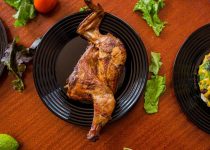How Long to Cook a 13lb Turkey in Rotisserie
So, you've decided to cook a 13lb turkey in a rotisserie – an impressive feat! You're probably wondering how long it will take to achieve that perfectly juicy and flavorful result. Well, the cooking time for a turkey in a rotisserie can be a bit different from traditional oven roasting, and it's crucial to get it just right to avoid dryness or undercooking.
But fear not, because with the right guidance, you'll soon be on your way to mastering the art of rotisserie turkey cooking. Let's walk through the steps together and ensure your Thanksgiving centerpiece turns out to be a showstopper.
Choosing the Right Rotisserie
When selecting a rotisserie for cooking a 13lb turkey, consider the size and weight capacity to ensure it can accommodate your bird. It's essential to choose a rotisserie that can handle the weight of your turkey and has enough room for it to rotate freely. Additionally, look for a rotisserie with adjustable settings to ensure even cooking and browning.
Once you have your rotisserie, proper maintenance is crucial for optimal performance. Regularly clean the rotisserie, removing any grease or food residue to prevent flare-ups and maintain the flavor of your turkey. Check the manufacturer's instructions for specific maintenance tips, as each rotisserie may have unique requirements.
When cooking a turkey in a rotisserie, basting is key to keeping the meat juicy and flavorful. Use a basting brush to apply a mixture of oil, herbs, and spices to the turkey every 30 minutes. This helps create a crispy, golden-brown skin while keeping the meat moist and delicious. Remember to close the lid quickly after basting to maintain the cooking temperature.
Choosing the right rotisserie and understanding proper maintenance and basting techniques are essential for successfully cooking a 13lb turkey.
Preparing the Turkey
To prepare the 13lb turkey for cooking in the rotisserie, thoroughly rinse it under cold water and pat it dry with paper towels. This helps to remove any excess fluids and ensures that the skin is ready for the brining process.
Brining is a crucial step as it involves soaking the turkey in a saltwater solution, sometimes mixed with herbs, spices, and other flavorings, to enhance its moisture and tenderness. This process also allows for flavor infusion, resulting in a more succulent and delicious bird.
After brining, it's time to consider the turkey basting. Basting the turkey with a mixture of butter, herbs, and spices during the cooking process not only keeps the meat moist but also contributes to achieving that irresistible golden brown skin. The basting process infuses the turkey with additional layers of flavor and helps to lock in juices, ensuring a mouthwatering result.
Calculating Cooking Time
Hey there!
When it comes to cooking a 13lb turkey in a rotisserie, the weight of the bird will affect the cooking time.
It's important to use a meat thermometer to ensure that the turkey is thoroughly cooked.
Keep these points in mind as we move on to the next steps for a perfectly roasted turkey.
Weight Affects Cooking Time
You can determine the cooking time for a 13lb turkey on a rotisserie by calculating roughly 15 minutes per pound, resulting in an estimated cooking time of about 3 hours and 15 minutes. However, it's essential to consider that weight affects cooking time, and factors like the turkey's overall size and shape can impact the duration needed for thorough cooking.
Here are some important points to keep in mind when considering how weight affects cooking time:
- Turkey Shape: A compact, broad turkey will cook more evenly and faster than a tall, narrow one.
- Rotisserie Size: Ensure that your rotisserie can accommodate the size and weight of the turkey for even cooking.
- Temperature Fluctuations: Larger turkeys may experience more temperature variations, so a reliable meat thermometer is crucial.
- Resting Period: Allowing the turkey to rest after cooking is vital for even distribution of juices and flavors.
Use a Meat Thermometer
Consider using a meat thermometer to accurately gauge the internal temperature of the turkey, ensuring it is thoroughly cooked and safe to eat. This ensures temperature accuracy and guarantees that your turkey is perfectly cooked. Place the meat thermometer in the thickest part of the turkey, avoiding contact with bones for an accurate reading. Here's a handy guide for the target internal temperatures:
| Turkey Part | Temperature | Done |
|---|---|---|
| Breast | 165°F | Yes |
| Thigh | 175°F | Yes |
| Stuffing | 165°F | Yes |
| Wings | 165°F | Yes |
| Drumsticks | 165°F | Yes |
Seasoning and Trussing
After patting the 13lb turkey dry with paper towels, season it generously with salt, pepper, and your choice of herbs and spices for added flavor. This will enhance the taste of the turkey and create a delicious outer crust during the rotisserie cooking process.
Once seasoned, truss the turkey by tying the legs together with kitchen twine and tucking the wing tips under the body. Trussing helps the turkey cook evenly and maintains its shape for a beautiful presentation.
Here are some additional tips for seasoning and trussing your turkey:
- Brining benefits: Consider brining the turkey before seasoning to lock in moisture and flavor. A brine solution of salt, sugar, and aromatics will infuse the turkey with extra juiciness and taste.
- Butter rub: Before seasoning, rub the turkey with a mixture of softened butter and herbs. This adds richness and helps the seasoning adhere to the skin, resulting in a crispy, flavorful exterior.
- Seasoning variations: Experiment with different herb and spice combinations such as rosemary and thyme, or paprika and garlic powder to customize the flavor profile of your turkey.
- Trussing techniques: Use a simple trussing method to secure the turkey's legs and wings, ensuring even cooking and a well-rounded shape.
Preheating the Rotisserie
Before you start cooking your 13lb turkey in the rotisserie, it's crucial to preheat the unit. This step ensures that the turkey cooks evenly and thoroughly.
Simply set the temperature to the recommended setting and allow the rotisserie to preheat for the specified time.
Preheating Time
To ensure the rotisserie is properly heated, begin preheating it to the recommended temperature according to the manufacturer's instructions.
Here are a few helpful tips for preheating your rotisserie:
- Follow the manufacturer's guidelines for preheating time and temperature to ensure even cooking and food safety.
- Always ensure that the rotisserie is placed on a stable and heat-resistant surface to prevent accidents and ensure rotisserie safety.
- Allow the rotisserie to preheat for at least 15-20 minutes before placing the turkey inside to ensure that it reaches the desired temperature.
- While the rotisserie is preheating, take the time to prepare your side dishes or check the turkey's seasoning and trussing to ensure a delicious and well-cooked meal.
Temperature Setting
Once the rotisserie has been properly preheated according to the manufacturer's guidelines, it's time to set the temperature for cooking your 13lb turkey.
Ensure the rotisserie is clean and well-maintained to prevent any issues during the cooking process.
Set the temperature to 325°F (163°C) for even cooking and to ensure the turkey reaches a safe internal temperature.
It's crucial to follow all safety precautions, such as using heat-resistant gloves when adjusting the temperature and avoiding contact with hot surfaces.
Additionally, make sure the rotisserie is placed on a stable, heat-resistant surface away from any flammable materials.
By maintaining the rotisserie and following safety guidelines, you can create a delicious and safe turkey for your gathering.
Happy cooking!
Monitoring the Cooking Progress
As the turkey rotates on the rotisserie, regularly check its internal temperature to ensure it's cooking evenly and reaching the desired doneness. Here are some essential steps to monitor the cooking progress effectively:
- Use a Meat Thermometer: Insert a meat thermometer into the thickest part of the turkey's thigh without touching the bone to check its internal temperature. Ensure it reaches at least 165°F (74°C) for safe consumption.
- Inspect for Even Browning: Periodically inspect the turkey for even browning. If certain areas are browning faster than others, use aluminum foil to cover those parts and promote even cooking.
- Baste the Turkey: If the skin appears to be drying out, baste the turkey with pan juices or a mixture of melted butter and herbs. This helps keep the meat moist and adds flavor.
- Check Rotisserie Stability: Throughout the cooking process, ensure that the rotisserie is stable and securely holding the turkey to prevent any accidents or uneven cooking.
Testing for Doneness
Regularly check the internal temperature of the turkey with a meat thermometer to ensure it has reached a safe temperature for consumption. Insert the meat thermometer into the thickest part of the turkey, such as the thigh and the breast, without touching the bone.
The turkey is safe to eat when it reaches an internal temperature of 165°F (73.9°C). However, don't rely solely on the thermometer; you should also use visual cues to determine doneness. Look for golden brown skin that's crispy to the touch. The juices should run clear when you pierce the turkey between the leg and the body, and the legs should move easily in their sockets.
Additionally, the meat should be opaque with no traces of pink, and the stuffing (if used) should have reached a safe temperature of 165°F (73.9°C) as well.
Once all these indicators align, your turkey is ready to be taken off the rotisserie and allowed to rest before carving. Remember, it's essential to confirm doneness using both internal temperature and visual cues to ensure a perfectly cooked turkey.
Frequently Asked Questions
Can I Use a Rotisserie to Cook a Turkey That Is Larger Than 13lbs?
Yes, you can use a rotisserie to cook a turkey larger than 13 lbs. However, if you're looking for alternatives, consider using a smoker or a traditional oven. Both methods can produce delicious, juicy turkey.
Is It Necessary to Brine the Turkey Before Cooking It in the Rotisserie?
Brining your turkey before cooking in the rotisserie can enhance flavor and juiciness. It's not necessary, but it's worth considering for a tastier result. If you're not brining, consider injecting flavor or using a dry rub for similar benefits.
Can I Use a Dry Rub or Marinade on the Turkey Before Cooking It in the Rotisserie?
Yes, you can use a dry rub or marinade on the turkey before cooking it in the rotisserie. Both methods are great for flavor infusion and pre-cooking preparation. They add delicious seasoning options to your turkey.
Should I Tie the Turkey Legs Together Before Placing It on the Rotisserie?
Before placing the turkey on the rotisserie for cooking, it's best to tie the turkey legs together. This helps the turkey cook evenly and ensures a beautiful presentation. Don't forget to baste and season for extra flavor!
Can I Open the Rotisserie During Cooking to Baste the Turkey With Butter or Other Seasonings?
Yes, you can open the rotisserie during cooking to baste the turkey with butter or other seasonings. This will help to keep the turkey moist and add flavor. It's a great technique for rotisserie cooking and seasoning.



